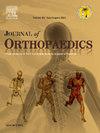评估倒刺缝合线:根据Silfverskiöld对z形成形术和翻转皮瓣的猪生物力学比较
IF 1.5
Q3 ORTHOPEDICS
引用次数: 0
摘要
在活体肌腱的修复和修复中,不可能添加无限量的缝合材料。每增加一个结,拉伸强度就会降低50%。因此,有刺缝线作为一种无结缝合系统,应该作为传统缝线的潜在替代方案进行研究,以最大限度地减少结相关的弱化。材料与方法猪浅表屈肌随机分为5组。采用非接触式测量。采用z形成形术,按照Silfverskiöld的方法进行翻瓣。将Stratafix倒刺无结缝线与常规光滑聚二恶酮缝线进行比较。生物力学方案包括蠕变试验、循环试验和撕裂试验。结果使用Stratafix的z型成形术比使用聚二氧英酮的z型成形术(PDS 108.5±22.2N, Stratafix 142.3±23.5N, p <;. 01)。z -成形术在最大力方面明显优于降压瓣(降压瓣加Stratafix 52.4±14.6N, z -成形术加Stratafix 108.5±22.2N, p <;措施)。结论与常规PDS相比,Stratafix倒钩缝线可显著提高z -成形术的最大张力达32%。为了制定更精确的指示,必须进一步研究生物因素。本文章由计算机程序翻译,如有差异,请以英文原文为准。
Evaluating barbed sutures: A porcine biomechanical comparison of Z-plasty and turndown flap according to Silfverskiöld
Introduction
It is not possible to add an infinite amount of suture material to tendon plasties and repairs in vivo. Each additional knot can reduce the tensile strength by up to 50 %. Therefore, barbed sutures, as a knotless suturing system, should be investigated as a potential alternative to traditional sutures to minimize knot-related weakening.
Material and methods
Superficial porcine flexors were randomized into five groups. A non-contact measurement was utilized. The Z-plasty and the turndown flap according to Silfverskiöld were used. The Stratafix barbed knotless suture was compared to regular smooth polydioxanone. The biomechanical protocol included a creep test, a cyclic test, and a tear-off test.
Results
The Z-plasty with Stratafix showed significantly improved maximum force compared to the Z-plasty with Polydioxanon (PDS 108.5 ± 22.2N, Stratafix 142.3 ± 23.5N, p < .01). The Z-plasty was significantly superior to the turndown flap in maximum Force (turndownflap with Stratafix 52.4 ± 14.6N, Z-plasty with Stratafix 108.5 ± 22.2N, p < .001).
Conclusion
The Stratafix barbed suture can significantly improve the Z-plasty in maximum tension by up to 32 % when compared to regular PDS. To formulate a more precise indication, biological factors must be further investigated.
求助全文
通过发布文献求助,成功后即可免费获取论文全文。
去求助
来源期刊

Journal of orthopaedics
ORTHOPEDICS-
CiteScore
3.50
自引率
6.70%
发文量
202
审稿时长
56 days
期刊介绍:
Journal of Orthopaedics aims to be a leading journal in orthopaedics and contribute towards the improvement of quality of orthopedic health care. The journal publishes original research work and review articles related to different aspects of orthopaedics including Arthroplasty, Arthroscopy, Sports Medicine, Trauma, Spine and Spinal deformities, Pediatric orthopaedics, limb reconstruction procedures, hand surgery, and orthopaedic oncology. It also publishes articles on continuing education, health-related information, case reports and letters to the editor. It is requested to note that the journal has an international readership and all submissions should be aimed at specifying something about the setting in which the work was conducted. Authors must also provide any specific reasons for the research and also provide an elaborate description of the results.
 求助内容:
求助内容: 应助结果提醒方式:
应助结果提醒方式:


